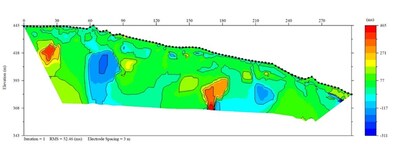Applied Graphite Reports Initial Geophysical Survey Results at the Queens Mine Complex
The preliminary geophysical survey results, from the first line, revealed three significant anomalies. One anomaly is located between the 165-185 meter-section along the profile, with a chargeability of approximately 400 mV/V. The second significant anomaly is located between the 12–30-meter sections along the profile, with a chargeability of about 350 mV/V. The third one is located between 100 and 125 m and seems to develop below the actual limit of detection of 60 m. All show significant extension below 60 metres. The electrode spacing is being widened to allow for depths of 300 metres or more. High chargeability, when combined with low resistivity, provides a strong geophysical signature for graphite exploration. The survey line was run over 300 metres, degrees off perpendicular to the known orientation of the graphite veins. Thus, an indication that the three anomalies may correspond to three graphite mineralized zones or swarms of graphite veins similar to the nearby Kahatagaha graphite mine, which has 32 vein systems, currently mining at 600m. The initial profile will be extended to the NNE to totally delineate the first conductive anomalies. The geophysics will now be plotted in 3D to locate the vertical graphite veins. Graphite is very conductive, so modern geophysics is a very useful tool to map the veins to depth.
"I am pleased to see the immense success of the initial results as we are introducing new methods in detecting graphite veins in
Graphite veins exhibit chargeability due to the unique electrical properties of graphite and its interaction with the surrounding rock. Graphite's high conductivity and polarizability result in a pronounced high chargeability anomaly when subjected to an electric field, as it easily facilitates electron movement and temporary charge storage. This high chargeability contrasts sharply with the lower chargeability of the surrounding rocks. During the geophysical survey, electrodes are arranged in configurations along survey lines, and an electrical current is injected into the ground. The voltage decay rate is measured and processed to create subsurface models of chargeability and resistivity. High chargeability zones, especially when correlated with low resistivity, indicate the presence of graphite veins. These anomalies are further interpreted using cross-sections and pseudo sections. The survey results are compared with surface geological maps, and high chargeability zones are targeted with drilling to confirm the presence, grade, and continuity of graphite. This approach ensures accurate identification and delineation of graphite veins, leveraging the distinct chargeability response of graphite in geophysical surveys.
About Applied Graphite Technologies
Applied Graphite Technologies is developing the
The technical information in this news release has been prepared by Dr.
Neither
This news release contains forward-looking information as such term is defined in applicable securities laws, which relate to future events or future performance and reflect management's current expectations and assumptions. The forward-looking information includes statements about Applied Graphite Technologies (AGT) 's plans. Such forward-looking statements reflect management's current beliefs and are based on assumptions made by and information currently available to AGT , including the assumption that approvals will be obtained. Investors are cautioned that these forward-looking statements are neither promises nor guarantees and are subject to risks and uncertainties that may cause future results to differ materially from those expected. Risk factors that could cause actual results to differ materially from the results expressed or implied by the forward-looking information include, among other things, an inability to access financing as needed. AGT cautions the reader that the above list of risk factors is not exhaustive. Except as required under applicable securities legislation, AGT undertakes no obligation to publicly update or revise forward-looking information.
SOURCE




